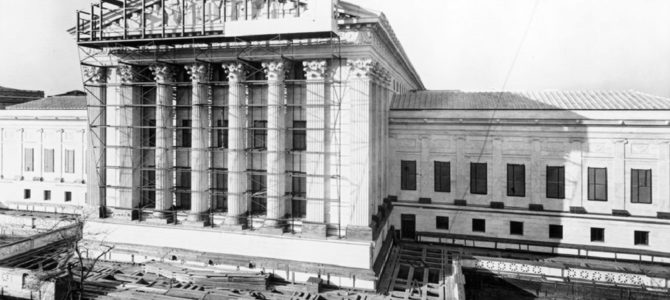
After President Trump announced his nomination of Judge Brett Kavanaugh to replace Justice Anthony Kennedy on the Supreme Court, many have been discussing the various justices’ judicial philosophies. The way the justices would exercise their power of judicial review has been central to this discussion.
Judicial review is currently revered in American political society. Judicial review is defined as the theory “that the actions of the executive and legislative branches of government are subject to review and possible invalidation by the judiciary.”
The ability for a court to refuse to apply an unconstitutional law is a concept that Founding Father Alexander Hamilton discusses in Federalist 78, with the first practical application of the idea occurring in the Marbury v. Madison ruling in 1803. While Chief Justice John Marshall did declare a law unconstitutional in his ruling, many today hold the distorted view that his decision affirmed the court to be the most powerful branch in determining the constitutionality of a government action. This warped view has become so common the other two branches of the federal government have acquiesced to even the most egregious unconstitutional dictates from the high court.
What Hamilton Says in Federalist 78
In Federalist 78, Hamilton describes the judicial power, which he calls “beyond comparison the weakest of the three departments of power.” Writing under the pseudonym Publius, Hamilton explains, “There is no position which depends on clearer principles, than that every act of a delegated authority, contrary to the tenor of the commission under which it is exercised, is void. No legislative act, therefore, contrary to the Constitution, can be valid.”
Hamilton goes on to state the court’s responsibility when facing such an act: “A constitution is, in fact, and must be regarded by the judges, as a fundamental law. It therefore belongs to them to ascertain its meaning, as well as the meaning of any particular act proceeding from the legislative body. If there should happen to be an irreconcilable variance between the two, that which has the superior obligation and validity ought, of course, to be preferred; or, in other words, the Constitution ought to be preferred to the statute, the intention of the people to the intention of their agents.”
The courts should not apply a law that directly violates the Constitution, he says. This was Hamilton’s explanation of the court’s role in determining constitutionality: If the courts face the potential of applying an “act contrary to the manifest tenor of Constitution,” they should defer to the Constitution by refusing to apply it on the plaintiffs before them.
Hamilton concludes by stating, “Nor does this conclusion by any means suppose a superiority of the judicial to the legislative power. It only supposes that the power of the people is superior to both; and that where the will of the legislature, declared in its statutes, stands in opposition to that of the people, declared in the Constitution, the judges ought to be governed by the latter rather than the former.”
What Happened in Marbury v. Madison
When John Adams lost his bid for reelection to bitter rival Thomas Jefferson in what Jefferson referred to as the “Revolution of 1800,” Adams decided to place as many Federalists—members of his political party—in national office as possible before he left the presidency. This litany of appointments resulted in his secretary of state, John Marshall, not being able to deliver all the commissions of these “midnight appointments” before Jefferson took office.
Since Jefferson wanted to place members of his party in these positions, he ordered his secretary of state, James Madison, to not deliver the remaining commissions. William Marbury, who did not have his commission delivered, filed a lawsuit against Madison, demanding that it be delivered. This was the case Marbury v. Madison.
Serving as chief justice of the Supreme Court, Adams’s former secretary of state John Marshall wrote the court’s unanimous (4-0) majority opinion, stating that while Marbury should receive his commission the court could not order it because the Judiciary Act of 1789 granted the Supreme Court original jurisdiction in a case not specified under Article 3 Section 2 of the Constitution. In short, Justice Marshall ruled the court could not apply a law that violates the Constitution.
In the decision, Marshall states that his oath to uphold the Constitution binds his decision-making, just as it binds the other branches:“It is apparent, that the framers of the constitution contemplated that instrument (the Constitution), as a rule for the government of courts, as well as of the legislature. Why otherwise does it direct the judges to take an oath to support it? This oath certainly applies, in an especial manner, to their conduct in their official character. How immoral to impose it on them, if they were to be used as the instruments, and the knowing instruments, for violating what they swear to support!”
Marshall does not say the judicial branch is the lone decider of what is constitutional. Marshall is claiming that the courts, like the other branches, cannot violate their oath to uphold the Constitution. Marshall simply followed his oath to preserve, protect, and defend the Constitution of the United States. This ruling is far from the preeminent judicial precedent many claim it to be.
Things Changed in Cooper v. Aaron in 1958
In 1958, the Supreme Court rewrote the authority of the Supreme Court by providing an alternative interpretation of Marbury v. Madison. While the Cooper v. Aaron case focused on the implementation of Brown v. Board of Education, in an opinion authored by all nine justices the court claimed that Marbury v. Madison “declared the basic principle that the federal judiciary is supreme in the exposition of the law of the Constitution, and that principle has ever since been respected by the Court and the country as a permanent and indispensable feature of our constitutional system.”
With this ruling, the courts claimed supremacy in defining the Constitution. Yet this court made a fundamentally false claim in its reasoning. The court misunderstood that when Article 6 of the Constitution states that the Constitution “shall be the supreme law of the land,” it is referring to the actual Constitution, not a court’s opinion on the Constitution. This becomes a crucial distinction when the country meets court opinions that rewrite or contradict the clear meaning of the Constitution.
As Supreme Court Justice Felix Frankfurter once emphasized, the significance lies in the “Constitution itself and not what we have said about it.”
The Myth of Judicial Supremacy
The courts’ claim to superiority contradicts Madison’s description of boundaries in the powers of the branches. Madison wrote in Federalist 49, “The several departments being perfectly co-ordinate by the terms of their common commission, none of them, it is evident, can pretend to an exclusive or superior right of settling the boundaries between their respective powers.”
The judiciary does not possess a greater power when constitutional questions arise between branches, no matter what a majority of Supreme Court justices may say. As Thomas Jefferson noted in a letter to William Jarvis, “to consider judges as the ultimate arbiters of all constitutional questions…would place us under the despotism of an oligarchy.”
When reflecting upon judicial review and the role of the judiciary, it is important to remember, as Pulitzer Prize-winning constitutional historian Charles Warren once noted, “however the Court may interpret the provisions of the Constitution, it is still the Constitution which is the law, not the decisions of the Court.”









